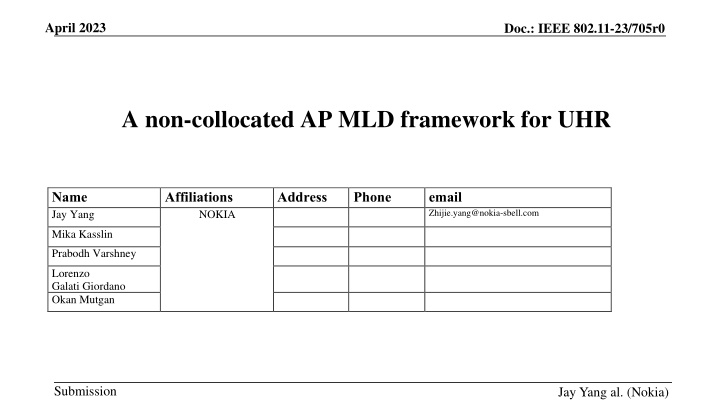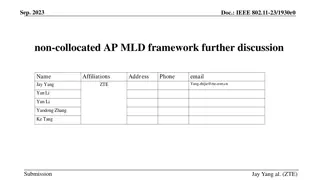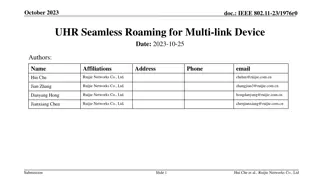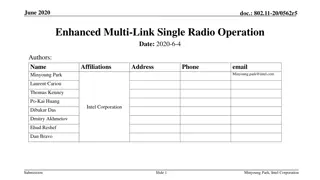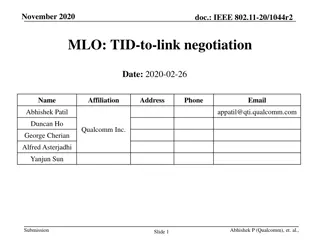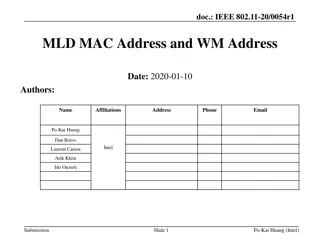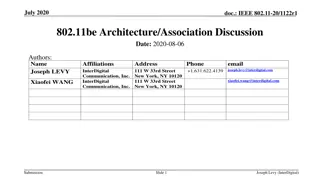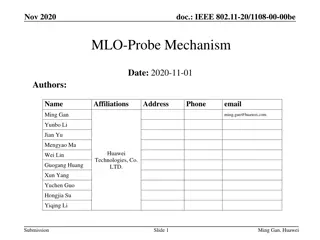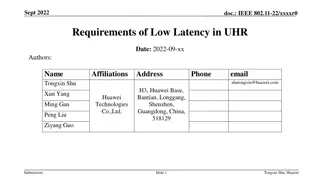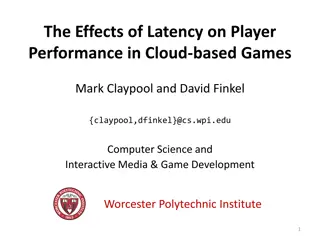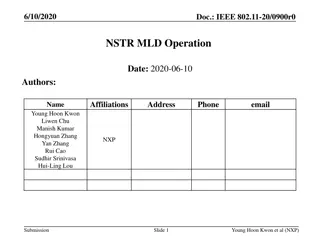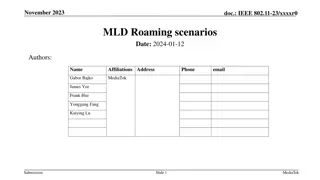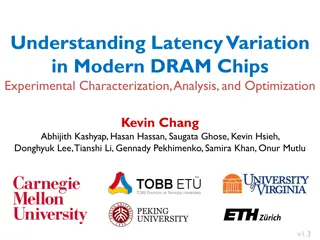Improving Latency Performance for Mobile Clients Using Non-Collocated AP MLD Framework
The UHR group aims to enhance latency performance for mobile clients by introducing a non-collocated AP MLD framework. This framework allows seamless transfer of client context between physical APs, improving roaming efficiency and supporting high numbers of links for non-AP MLDs. The proposed solution addresses potential mismatch issues between high-end non-AP MLDs and basic AP MLDs, offering a cohesive approach for setup and maintenance of links for both static and mobile devices.
Download Presentation

Please find below an Image/Link to download the presentation.
The content on the website is provided AS IS for your information and personal use only. It may not be sold, licensed, or shared on other websites without obtaining consent from the author.If you encounter any issues during the download, it is possible that the publisher has removed the file from their server.
You are allowed to download the files provided on this website for personal or commercial use, subject to the condition that they are used lawfully. All files are the property of their respective owners.
The content on the website is provided AS IS for your information and personal use only. It may not be sold, licensed, or shared on other websites without obtaining consent from the author.
E N D
Presentation Transcript
April 2023 Doc.: IEEE 802.11-23/705r0 A non-collocated AP MLD framework for UHR Name Jay Yang Affiliations NOKIA Address Phone email Zhijie.yang@nokia-sbell.com Mika Kasslin Prabodh Varshney Lorenzo Galati Giordano Okan Mutgan Submission Jay Yang al. (Nokia)
April 2023 Doc.: IEEE 802.11-23/705r0 Introduction Per the UHR PAR, the UHR group intends to improve latency performance of mobile clients at least one mode of operation capable of improving the tail of the latency distribution and jitter compared to Extremely High Throughput MAC/PHY operation, with mobility between BSSs Quite a few UHR SG contributions have already talked about this [2] proposes a new non-collocated AP MLD framework within which context of a client is transferred from one physical AP to another when the setup links move from one physical AP to another physical AP. [3] proposes a non-collocated affiliated APs coordination framework with the MLD high MAC as the coordinator and each affiliated AP as the coordinated AP In this contribution, we talk about similar approach with the objective to have a solution that not only targets hitless roaming but that is also able to provide high number of links for non-AP MLDs with AP MLDs that have only few Wi-Fi radios Submission Jay Yang al. (Nokia)
April 2023 Possible mismatch between high end non-AP MLDs and basic AP MLDs Doc.: IEEE 802.11-23/705r0 High-end non-AP MLDs are expected to emerge in the market with at least three links operating in 2.4 GHz, 5 GHz and 6 GHz At the same time, we can expect dual radio APs to be common at least in residential market Could we find a solution with which number of radios in AP MLDs don t limit number of simultaneous links in those non-AP MLDs that can run high number of links? The following slides talk about one possible approach Submission Slide 3 Jay Yang, et al. (Nokia)
April 2023 Doc.: IEEE 802.11-23/705r0 High level of the proposed solution One possible solution is to have the UHR to address case of links that are setup to non-collocated APs We acknowledge that nothing in the 802.11be draft prevents APs affiliated to an AP MLD to be collocated, but it assumes that Our proposal is that the UHR group further develops the AP MLD concept and specifies all the required means to 1. Discover non-collocated APs to which links may be setup, 2. Setup links to non-collocated APs, and 3. Maintain links to non-collocated APs All this considering both static and mobile non-AP devices which may all experience situations that need changes in setup links Submission Slide 4 Jay Yang, et al. (Nokia)
April 2023 Doc.: IEEE 802.11-23/705r0 Proposed solution in reference model The 802.11be reference model (figure on the right) has the MLD upper MAC and MLD lower MAC specified as functionality split without any service interface The proposal to have UHR to develop solution which allows links to be setup to non-collocated APs means that the MLD upper MAC and the MLD lower MAC of a UHR AP may be in different physical devices and no longer collocated The UHR reference model looks very similar to the 802.11be reference model The main difference is that the interface between the MLD upper MAC and the MLD lower MAC should be specified while maintaining flexibility for different implementations Submission Slide 5 Jay Yang, et al. (Nokia)
April 2023 Doc.: IEEE 802.11-23/705r0 One implementation and deployment example for consideration Physical AP1 MLD upper MAC Three AP devices which each have two radios but with shared MLD upper MAC in one of the AP devices they can provide three links to a high-end mobile device Backhaul implements the service interface between the MLD upper MAC and the MLD lower MAC and it may be wireline or wireless backhaul backhaul AP1.1 2.4 GHz AP1.2 6 GHz Physical AP3 Physical AP2 AP2.2 6 GHz AP2.1 5 GHz AP3.2 6 GHz AP3.1 5 GHz Submission Slide 6 Jay Yang, et al. (Nokia)
April 2023 Doc.: IEEE 802.11-23/705r0 Another implementation and deployment example for consideration MLD upper MAC AP1(2.4GHz) AP1(5GHz) AP1(5GHz) AP1(5GHz) AP1(2.4GHz) AP1(2.4GHz) AP2(6GHz) AP2(6GHz) AP2(6GHz) AP2(6GHz) AP2(6GHz) Physical AP1 Physical AP6 Physical AP5 Physical AP3 Physical AP2 Physical AP4 High number of AP devices with few radios MLD upper MAC may be even a controller like entity which interfaces with the MLD lower MACs of AP devices over selected media 2.4 & 5 & 6GHz Submission Slide 7 Jay Yang, et al. (Nokia)
April 2023 Doc.: IEEE 802.11-23/705r0 Third implementation and deployment example for consideration The solution could be applied also to an example implementation of a UHR AP which has three radio modules connected to a network processor via PCIE interface The network processor implements the MLD upper MAC Each radio module implements the MLD lower MAC Even though this is not related to non-collocated APs which provides links under control of common MLD upper MAC, this is an example of deploying media independent but detailed specification of interface between the MLD upper MAC and two or more MLD lower MACs Network processor PCIE-1 Wireless module1 2.4GHz PCIE-2 Wireless module2 (5GHz) PCIE-3 Wireless module3 (6GHz) Submission Slide 8 Jay Yang, et al. (Nokia)
April 2023 Doc.: IEEE 802.11-23/705r0 MLD upper MAC MLD lower MAC interface Our proposal is to specify the interface so that the MLD upper MAC and MLD lower MAC may be from different vendors The interface should be an exposed interface Different physical media can be used to implement the interface The UHR group should not specify media dependent details but provide interface specification which is detailed enough for interoperable implementations One possible approach is to specify virtual communication port between MLD upper MAC and MLD lower MAC so that they can communicate with each other via various medium connection Submission Slide 9 Jay Yang, et al. (Nokia)
April 2023 Doc.: IEEE 802.11-23/705r0 THANK YOU Submission
April 2023 Doc.: IEEE 802.11-23/705r0 reference [1] 11-23-0480-00-0uhr-uhr-proposed-par.pdf [2] 11-22-1910-03-0uhr-seamless-roaming-for-uhr.pptx [3] 11-22-1512-00-0uhr-multi-ap-coordination-for-uhr.pptx Submission Slide 11 Jay Yang, et al. (Nokia)
